
GLENN LONEY'S SHOW NOTES
By Glenn Loney, September 5, 2000
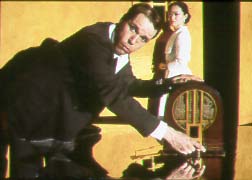
| |
| SEARCHING FOR ORSON WELLES--Anne Bogart's SITI ensemble at the Edinburgh Festival with "War of the Worlds." Photo: ©John Nation. | |
[02] Anne Bogart's "Cabin Pressure" & "War of the Worlds"
[03] Argentine Bathroom Drama
[04] Chausson's "le Roi Arthus"
[05] Scottish Opera's New "Rheingold"
[06] "Boulez 2000"
[07] Emio Greco's "Extra Dry"
[08] Sasha Waltz's Berlin "Körper"
[09] Mathilde Monnier's Montpellier Ensemble
[10] Foraging on the Fringe/Traverse Theatre
[11] "Further Than the Furthest Thing"
[12] "Shetland Saga"
[13] Irish Soccer: "Alone It Stands"
[14] One Yellow Rabbit's "Thunderstruck"
[15] "Voices" from Hollandia
[16] Ridiculusmus' "Say Nothing"
You can use your browser's "find" function to skip to articles on any of these topics instead of scrolling down. Click the "FIND" button or drop down the "EDIT" menu and choose "FIND."
How to contact Glenn Loney: Please email invitations and personal correspondences to Mr. Loney via Editor, New York Theatre Wire. Do not send faxes regarding such matters to The Everett Collection, which is only responsible for making Loney's INFOTOGRAPHY photo-images available for commercial and editorial uses.
How to purchase rights to photos by Glenn Loney: For editorial and commercial uses of the Glenn Loney INFOTOGRAPHY/ArtsArchive of international photo-images, contact THE EVERETT COLLECTION, 104 West 27th Street, NYC 10010. Phone: 212-255-8610/FAX: 212-255-8612.
For a selection of Glenn Loney's previous columns, click here.
EDINBURGH FESTIVAL 2000
Theatre Thin on the Ground of Main Festival—
Although the Edinburgh Festival was originally launched with opera productions from Glyndebourne, over the years, theatre-stagings came to have an increasing role. So much so, that after Frank Dunlop had been Festival director for a time, he was accused of making it almost indistinguishable from the Festival Fringe.With the advent of Brian McMaster as director, the emphasis has shifted. Not back to opera, but onward to dance and dance-theatre. So it is always welcome when McMaster programs some innovative theatre productions.
Some of his recent choices, however, have been a bit too trendy for many. The King's Theatre was poorly populated the evening I witnessed Valle-Inclán's aptly titled "Barbaric Comedies."
And, as the four-hour marathon progressed, some of the seniors in the auditorium voted with their feet against the production.
Dublin's Abbey Theatre Presents
Valle-Inclán's "Barbaric Comedies"
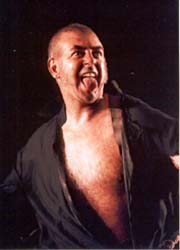
| |
| OUT OF CONTROL--A lusty moment in Valle-Inclán's "Barbaric Comedies," performed by Dublin's Abbey Theatre at the Edinburgh Festival. Photo: ©Douglas Robertson. | |
Commentators have considered this trilogy of the Fall of the House of Don Juan Miguel de Montenegro to be almost cinematic in its construction. And, as a result, almost impossible to stage effectively.
The talented ensemble of the Abbey Theatre have proved otherwise, in this four-hour-long production of the three plays. They are, of course, immeasurably assisted in this achievement by the daring Catalan director, Calixto Bieito.
His staging of Calderon's La Vida Es Sueño—seen both at the Edinburgh Festival and at Brooklyn's BAM—gave some hint of the ferocity with which he would mount this three-part work. It would be a coup for BAM to bring Barbaric Comedies to New York audiences. BAM regulars by now are prepared for anything.
At the outset, it seemed super-titles might be needed. But not because the texts were performed in the original Spanish. The Abbey actors launched into the action with such intensity and speed that it took a while to adjust to the Erse accents.
The new translation is by Frank McGuinness, one of Ireland's most acclaimed and interesting playwrights. It might seem strange that he would be attracted to an apocalyptic Spanish tragedy, so far removed from Irish tradition.
And yet there is a mytho-historical link between the Irish and these fantastic characters from Galicia in Northern Spain.
It has long been believed—both in Galicia and Ireland, both historic homes of Celtic tribes—that Galicians emigrated on small boats to Ireland long before the First Millennium. Some even speculate that these Celts came originally from the Holy Land—and may have been one of the Lost Tribes of Israel.
Certainly there is a long tradition in Ireland of a Spanish blood-inheritance. Whether from wrecked Spanish pirates or some sailors on ships of the ill-fated Spanish Armada… But the blood-link must be centuries older.
Whatever the mythical affinities of Irish and Galicians, Frank McGuinness has already shown himself an able translator of Norwegian and classic Greek dramas. Both his versions of Ibsen's Doll's House and Sophocles' Electra were shown on Broadway and in London's West End.
The trio of dramas which make up Barbaric Comedies consists of Silver Face, Eagle Rampant, and Romance of the Wolves. They are, in effect, three deconstructive stations in the story of the brutal, cruel, sensual, selfish, and atheist patriarch, Don Juan de Montenegro, powerfully played by Mark Lambert.
He makes the arrogant, sensual, wife-cheating Spanish aristocrat, Count Almaviva—in Beaumarchais' and Da Ponte's dramatic depictions—seem a thoughtful gentleman, in comparison. Even Da Ponte & Mozart's Sevillian nobleman, Don Giovanni, seems tender towards women, set against Montenegro's brutal lusts.
Montenegro treats his body-servant literally like a dog, making him chase after bones. His long-suffering, super-religious wife's god-daughter he reduces to abject and strangely willing slavery.
He has six sons, all of whom have inherited their father's worst qualities—and added some of their own. Near the end of the trilogy, the abandoned Montenegro is playing Lear on a heath with the town fool, cursing his sons.
But he has done nothing but curse them from the outset. And given them nothing but his name—and with it, the privilege of being above the rest of their community and acting accordingly. So he lacks Lear's reasons for reproach.
In fact, he has kept his power and possessions so closely in hand, that some of his sons even mask themselves and break into his house, almost killing him in the attempt to rob.
When his noble, ever-forgiving wife [Joan O'Hara] has only just died, her rapidly rotting body in the family chapel's crypt, two of his sons—one of them the scandalous young priest, Don Farruquino [Owen Sharpe]—break in and rob the altar of its treasures. The mocking priest insists on the best of the loot "for my Order."
Silver Face [Karl Shiels] is the town nick-name for the eldest and handsomest of the rapacious brothers. If he cannot win a maid with his good looks, he will take her violently. And he is not the only brother so inclined.
Montenegro has already taken care of one son, by "giving him to the Church." But, denied proper patrimonies, all the sons take what they can from the community.
The Miller's wife, Liberata [Tonia Chauvet], is told by one son that she and her husband—although they pay rent to Don Juan—must immediately vacate. She angrily insists on their rights as tenants.
He attacks her savagely, biting and beating her. And then violently raping her. I was not the only one in the Edinburgh audience who could hardly bear to look at this on stage.
Director Bieito spares his audience and actors nothing. And the most bestial and cruel of actions are presented with a vividness and immediacy which leave little room for the laughter suggested by the triad's ironic title.
These are Commedia only in the Dantean sense. No laughing matter here.
That Valle-Inclán had a rather jaundiced, ironic view of the world around him was not only a product of his drug-habit, his Mexican interlude, and his experiences as a war-correspondent. But also of the time and the Spain in which he lived.
He anticipated Artaud, Arrabal, and Ionesco—and all the Surrealists—in his evocation of the grotesque through his theory of Esperpento: the "recording of reality in a concave mirror…"
As the program notes: " Esperpento is part of a tradition which re-orients the reader/spectator through its blurring of the distinctions between the tragic and the comic, the bizarre and the conventional, and real and the unreal, fiction and history."
As the Barcelona architectures of Antonio Gaudi and the recent exploits of Catalan theatre-makers amply demonstrate, Catalonians, like Galicians, have a talent for the Absurd and Grotesque.
Calixto Bieito is ably assisted in staging his vision of a superstitious, priest-ridden, aristocrat-dominated Spain, emerging with difficulty from the ancient feudal order of society.
Not only the excellent, passionate actors of the Abbey Theatre bring the dramas to life, but designers Alfons Flores [sets], Marcé Paloma [costumes], and Xavier Clot [lighting] work wonders on a virtually bare black stage.
Hanging obliquely overhead is an immense black wrought-iron altar screen, like the one from Valladolid in the Metropolitan Museum. Its gates open downward from time to time to allow an enormous inverted crucifix, a great bed, a baroque altar, or a long baronial table to descend.
Effective music is provided by composer Oscar Roig.
Barbaric Comedies makes García Lorca's unforgiving Yerma or Noces de Sangre seem rather tame in comparison.
Anne Bogart's SITI Troupe Dazzle at the Lyceum
With "Cabin Pressure" & Welles' "War of the Worlds"
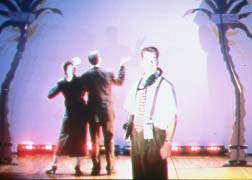
| |
| "THEATRICAL" MOMENT--Players in Anne Bogart's "Cabin Pressure." | |
Several seasons ago, I encountered him as we were squeezing into a tiny studio-space at Actors Theatre Louisville. I was surprised that he might be considering Anne Bogart's SITI ensemble for the Festival.
But, after seeing "Cabin Pressure," he told me how much he admired her innovative work, which has strong elements of dance-theatre in it. A genre of which he is especially fond…
I was dubious, considering the way in which this ingenious commentary on audience-responses to live theatre was developed. Keyed as it was to Louisville audiences.
What I failed to realize was that the dumb or odd comments people may make to poll-takers or interviewers after a specific theatre-event do not need to relate to a particular place or play to be appreciated by quite different audiences: Spectators who are hearing the comments re-stated in a theatre-piece such as this, thousands of miles from the point of origin..
In fact, Edinburgh audiences were even more responsive than those at the Humana Festival.
"Cabin Pressure" also benefited from being produced on the proscenium-arch stage of the Royal Lyceum Theatre. Instead of being cramped against a wall of a small basic-box with tiered-seating on three sides.
The repetitions of a tea-scene from Noël Coward's "Private Lives" took on new effectiveness in the new frame. As did the often hilarious—and sometimes enigmatic—responses of queried spectators.
There was also more freedom and focus for the movement of the actors of the ensemble, swirling about with their folding-chairs.
The proscenium stage was also a better frame for Bogart's surreal survey of the career of Orson Welles, "War of the Worlds." This was shown on an open stage last March at the Humana Festival, but it works much better in a conventional theatre.
Its cinematic frames, its filmic structure, its ingenious choreographies: all showed to much stronger advantage on a proscenium stage.
The only visual problem was Bogart's building up the performance stage-floor nearly three feet from the original stage. This meant those of us sitting in the front rows couldn't see feet, or even legs, of some actors standing close to us.
Although conceived and directed by Bogart—and developed in rehearsals with her SITI performance ensemble—"War" has a text written by ensemble-member Naomi Iizuka.
Some British critics found it less than effective in telling Welles' story, but Welles was famously inventive—or vague—about his past exploits.
The SITI framework for dealing with the huge talent of what became a gargantuan fat-man was the device of interviewing everyone Welles had known to piece together a filmic biography.
It effectively opened with a reprise of part of the Mercury Theatre's radio-broadcast of Welles' adaptation of H. G. Wells' early Sci-Fi novel, "War of the Worlds."
A keyword in this search for the Real Welles was the last word he ever uttered: "Thorn."
When I first heard this in the Louisville performance, I thought it might refer to Citizen Kane's childhood sled, "Rosebud"—which was Kane's last word.
Roses seldom come without thorns, and the aftermath of making "Kane" proved thorny indeed for Welles.
The best guess of the on-stage interviewers was that Welles might have been referring to the remarkable miniature Thorne rooms in the Chicago Institute of Art.
Mrs. Thorne created tiny period interiors, complete with sunny gardens outside the windows. Each is like a small stage-set, just waiting for its miniature actors to appear.
As in Louisville at the Humana Festival, Stephen Webber was outstanding as Orson Welles. The SITI ensemble even gave a radio-reading of the original broadcast of "War of the Worlds" as a special evening theatre-event.
Admirable were the entire ensemble: Will Bond, Ellen Laurer, Barney O'Hanlon, Tom Nelis, J. Ed Araiza. Akiko Aizawa, and, of course, Webber. They have just been performing this work at BAM in Brooklyn.
Argentines in the Bathroom: Having a Splash
In Leon's Mil quinientos metros sobre el nivel de Jack
Deep-sea-diving isn't easy in a Buenos Aires bathroom, but the feckless Gaston [Luis Ziembrowski] and little fatherless Enso [Ignacio Rogers] have a go at it. The problem is that the tub is already occupied by Mother [Beatriz Thibaudin], who seems to live there. Gaston has brought his girlfriend Lisa [Carla Crespo] home with her son, whose father has long since vanished. Gaston wears a wet-suit, and so Lisa rents one for Enso so he can follow suit, so to speak.
There is also a TV in the bathroom which they indolently watch intermittently.
At one point, they are all in the tub together. At least Gaston doesn't put the TV in the water as well.
Author-director Federico León's drama is apparently an outstanding example of new Argentinean Alternative Theatre. Its English title is: "One-thousand-five-hundred meters above the level of Jack."
It may be new to Argentines, but Ellen Stewart was showing this kind of theatre at La MaMa ETC way back in the 1960s!
Fortunately, there were English super-titles in Edinburgh. What a man will not do to win the love of a lady with an orphaned son! At least I think that's what was at issue.
A Brief Taste of Festival Opera—
Under the late Sir Rudolf Bing, the Edinburgh Festival was founded with notable and innovative opera productions, imported from England's Glyndebourne Opera Festival.Opera is still an important component of the northern fest, but productions seem fewer, and often less striking, than in past years.
The major problem with festival opera production—whether mounted on home-stages, or borrowed from other cities—is the tremendous cost: major voices, chorus, and orchestra all cost a lot of money.
Not to mention the expense of directors & designers, with new sets and costumes. Touring is now a ruinous adventure as well.
So it's no wonder Brian McMaster favors ballet and modern dance ensembles. It is nice to have a full orchestra, but dancers can and do often perform to taped music.
Modern works seem to thrive on black-box stages and black rehearsal costumes, so there's a lot of cost-effectiveness in programming avant-garde dance experiments.
Experimental or "difficult" operas also don't fill the seats of Edinburgh's cavernous King's and Festival Theatres.
Chausson's le Roi Arthus in Concert
Composer Ernest Chausson's version of the King Arthur legend is compelling musically and dramatically. He drafted his own libretto—following the example of Richard Wagner—so the work is especially consonant and powerful.So it is unfortunate that it is so seldom performed, even in concert.
Several seasons ago at the Bregenz Festival, it was given full-stage treatment in a remarkably inventive Post-Modernist production. This demonstrated its powers, but it has not exactly been drawn into the repertory as a result.
It is certainly no "Camelot." In Chausson's wrenching vision, it is Arthur's beloved Queen Genièvre—Guinivere—who betrays him more than his trusted knight, Lancelot.
She lusts after the loyal Lancelot, torn between his friendship with the King and his ardor for the beauteous temptress. She it is who brings on the final fatal disaster for them all.
In concert at the Edinburgh Festival, unfortunately, the dramatic and musical powers of Chausson's masterwork were muted. But not because the Royal Scottish National Orchestra—under the baton of Frédéric Chaslin—were derelict in their duties.
Simon Keenleyside, as Arthus, was powerful, and Hubert Delamboye's Lancelot was affecting. Although it is difficult to visualize this tragedy-in-music when the legendary warriors are all in white-tie & tails.
The major dramatic problem—and musical as well— was posed by the abundantly ample Genièvre of Françoise Pollet. She was often not able to produce tones of sufficient power to over-ride the orchestra. Nor did her interpretation suggest the wily, manipulative emotions of this famous female demon-lover.
Scotland the Brave!
Scottish Opera Launches a New RING Cycle
With Wagner's Demanding Das Rheingold
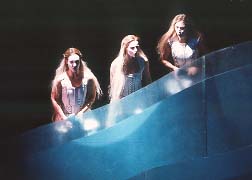
| |
| SINGING IN THE RHINE!--Richard Wagner's Three Rhine-Maidens do their thing in "Das Rheingold." | |
Now that Scotland has devolved from the United Kingdom sufficiently to have its own flag again and its own Parliament, it's obviously important for Scots' Pride to have its own opera back on top, as well.
With the mounting of Wagner's Das Rheingold—in association with the Edinburgh Festival—Scottish Opera is making a strong statement of its will, not only to survive, but to achieve eminence once again.
This will be a four-year cycle, for it is virtually impossible for any opera-house in the world—except for Wagner's Bayreuth Festspielhaus—to mount all four of the RING Cycle operas in one season. Let alone in one week, as is the custom in Bayreuth.
Not only does the RING require some 16 hours of stage-time, but it has many potential set-changes. The most difficult and demanding scenic environments are specified for the Prologue or Vorabend, which is Das Rheingold. Although it is only about 2-and-a-half hours long, with no intermission to aid in scene-changes.
Fortunately, the German designer, Hildegard Bechtler has conceived basic set-shells which can be moved about to suggest different locales. These can obviously be used in different conformations for scenes in the remaining three operas in the RING.
First seen, one of the concave set-sections—standing from upstage to downstage left—rises a bit forward of the stage-right shell, providing a wide upstage center entry-way. The shells can be reversed to show their convex sides, as well. They also aid in directing the sound towards the audience.
Rippling translucent blue wave-forms rise in front of ramps butting onto the stage-left shell. The three Rhine-maidens, in sexy outfits and high-heels, scamper up and down among these stylized waves, driving the lusty dwarf Alberich crazy with desire.
It is very much to the credit of director Tim Albery and his talented cast that the all-too-human emotions involved in all the scenes are so strongly played that they are bodily and gesturally visible—as well as potently audible in Wagner's music & libretto and their singing of it.
Among the talents are Matthew Best/Wotan, Anne Mason/Fricka, Peter Sidhom/Alberich, Markus Hollop/Fafner, and Peter Bronder as Loge.
That the Fire God, Loge, looks rather like an ageing Andy Warhol must be the idea of costume-designer Ana Jebens. She and Bechtler must have been looking at the drawing-boards for the new Bayreuth RING—designed by Erich Wonder and Florence Von Gerkan—for the major males wear business-suit jackets and vests.
Instead of Bayreuth trousers, however, the men wear long wrap-around skirts. This is OK in Scotland, the home of the kilt, but it might be awkward if it catches on elsewhere.
The worker-giants, Fafner and Fasolt, are outfitted like British factory-workers or craftsmen, in blue overalls and caps. They enter, peering out of the eye-sockets of a sideways-rolling giant mask.
Down in the darkness of Nibelhiem, Alberich's tiny dwarfs are distinguished by eyes which seem to be electric goggles. They sort gold into sacks at tables rather like those Erich Wonder has created for the new Bayreuth RING.
So, if you cannot get a ticket for Bayreuth next year—and very few can—it may be worthwhile to go to Edinburgh instead.
In their new Valhalla home, Wotan and Fricka sleep uneasily on an inclined bed which seems to be a sheet of slate on a stone podium. This can be read as a visual metaphor for their marriage.
It also offers a rocky height for the gods to look loftily down on the giants. That doesn't bother the big builders. They know they have the upper-hand. And they are about to rob the gods of their eternal youth, by taking away the goddess Freia—whose golden apples have kept them young. The gods rapidly age—as at Bayreuth.
In recent years, Wagnerian traditionalists have continually complained about the lack of a credible Rainbow Bridge into Valhalla in major avant-garde stagings of the RING Cycle.
Nor do they get a conventional solution at the Scottish opera either. Instead, Hildegard Bechtler provides some vertical tubes into which the gods step—with the aid of a red step-ladder held by Loge.
Production photos show them in the air at various levels, but in performance, they never take off.
Fortunately—also thanks to conductor Richard Armstrong and the orchestra—the production does take off!
Boulez 2000!
Österreich Über Alles!
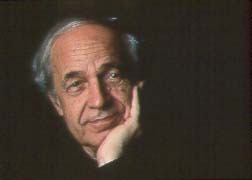
| |
| PIERRE BOULEZ AT 2000--Conducts Edinburgh Festival concert of Austrian music denounced by Jörg Haider, leader of Far Rightists. Photo: ©Philippe Gontier. | |
Formerly chief of the New York Philharmonic, Boulez used to upset traditionalists by suggesting that all opera-houses should be burnt down. This unfortunately has happened to some notable houses—Teatro Fenice in Venice, for example. But the arson was probably not caused by lovers of New Music.
Unfortunately, there are other Brandstifter—or firebugs—at work now. As in the time of Adolf Hitler and the Nazis, they want to destroy modern movements in music and art.
The Nazis branded the music of Gustav Mahler and Alban Berg, for example, as "Degenerate Music."
So it was entirely appropriate in a major protest concert in Vienna—on 4 February, when the new ultra-conservative government was sworn in—that both Mahler and Berg were programmed.
For Edinburgh, Pierre Boulez chose the same composers and the same works. He included as well the Festival's co-commissioned new work of Olga Neuwirth—who not so incidentally attacked the Austrian government's actions against the arts at a mass-meeting before the Vienna State Opera in February.
Alban Berg's Drei Orchesterstücke, Op. 6, was cutting-edge New Music in its day, but it sounds almost conventional now. That is, compared with Olga Neuwirth's challenging Clinamen/Nodus. Boulez and the LSO gave both works dynamic readings
At the interval in Edinburgh's majestic Jugendstil Usher Hall—now in the process of a major restoration—a kilted Edinburgher could be heard saying to his group: "That was a bit wicky, wasn't it? Let's hope the Mahler isn't so extreme."
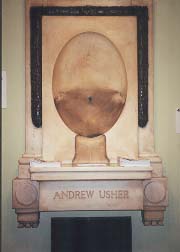
| |
| THE MAN WHO WASN'T THERE--In Edinburgh's famed Usher Concert Hall, the bust of Patron Andrew Usher has vanished. Photo: ©Glenn Loney 2000/The Everett Collection. | |
With the full forces of the orchestra—and an abundance of percussion—Boulez conducted with both vigor and subtlety, as the passions implicit in the score soared and abated. That the first movement was to suggest the essence of Mahler's amazing wife, Alma, gives scope for conjecture.
Composed as Mahler was also working on Kindertotenlieder, the symphony foreshadows the three catastrophes which finally finished him. Alma Mahler is quoted in the program notes: "Not one of his works came so directly from his inmost heart as this…the most completely personal of his works and a prophetic one too. …he anticipated his own life in music. On him, too, fell three flows of fate, and the last felled him."
The actual musical blows were produced by slamming down a huge wooden mallet on a wooden sounding-box. But these were only highlights among the crashing crescendos of the final movement.
Speaking of striking blows, the young Austrian composer Olga Neuwirth struck one for artistic freedom in a passionate speech this past February in front of the Wiener Staatsoper.
As Neuwirth is an uncompromising modernist, she was an obvious local Viennese target of neo-fascist politician Jörg Haider's attack on "Weltkatzenmusik."
Reminding many of the views of his idol, Adolf Hitler, regarding so-called "Degenerate Music," Haider took the occasion of his 50th birthday in the Austrian Alps to denounce "the caterwaul of world music."
Even the title of Neuwirth's new work, Clinamen/Nodus, should be enough to enrage the Minister-President of Carinthia—who is now Klagenfurt's leading music-critic—Jörg Haider. "Climamen" is Freud's word for "the unforseeable and the momentum of catastrophe." It suggests the modern "unpredictability of the musical process."
"Nodus" is a knot or a knotty problem. In Neuwirth's baffling piece—as noted in the program—it "refers in a figurative sense to a moment of bewilderment in which everything is gridlocked."
Haider might have apoplexy just reading the program-notes—even without hearing the puzzling composition:
"The work begins with a chaotic sound configuration containing various options for future development: it is the point of departure for constantly shifting musical shapes, mechanically repeated rhythms which grow denser as they overlay one another, and for the resultant immobile planes of sound in which the music is ensnared."
Yes. And there's more of the same, which is the verbal equivalent of the score.
Nonetheless, in a nominally free country—Austria—Neuwirth should have every right not only to say what she thinks, compose what her inspiration prompts her to, and to hear it performed by the best musicians.
In fact, this new work was jointly commissioned by the LSO, the Cologne Symphony, the Brussels Philharmonic, Carnegie Hall, the Vienna Concert House, the Salzburg Festival, the Edinburgh Festival, the Lucerne Music Festival, and Brussels 2000.
Obviously, Olga Neuwirth has a lot of prestigious admirers and defenders!
She may need them after Haider's frontal attack on modern music.
After the coalition of the Austrian People's Party—the ÖVP—and Haider's smaller party brought them to power recently, the arts were at the top of the list of government subsidy slashes.
Atthe mass-meeting on 19 February, in front of the Vienna State Opera, Neuwirth said in part:
"I'm standing up here as an artist representing a younger generation, and one who has been doubly affronted: there is no longer a Ministry for Women, or a Ministry of Arts. Both of these ministries which were fought for ferociously in the 1970s have been abolished overnight. That probably shows how little these two domains mean to the political ruling class.
"As a composer, can I really protest on my own ground, with music? Be that as it may, where such things happen, I won't be silent. In an era that rejects art and artists, that regards them as useless, as a curiosity, artists do what they must…"
"This is the only kind of reaction that is left to them in moments of crisis, chaos, the abuse of human rights, intolerance, and in uncertain times. Showing that they can thrill, excite, consciously apply principles of expression and construction, create awareness of the creative act: that's the only reactive option artists have."
"For me as a composer, the meaning of music can't be a matter of soothing people and making them compliant by promising a communal spirit that crosses all frontiers. I can't make reality any better than it is.
"I would like my listeners to be people who consciously think things over, who think for themselves, who regard music and art as a whole as a mirror of human searching, of people who want to grasp how things are, to cast off impositions and to leap into the unknown and thus become more open and tolerant towards their surroundings.
"I'm not out to preach to anyone, but I want my music to convey ideas about the pain and tenderness that pervade the world, the obvious ambivalence and sense of human futility that surrounds us. I know art can't change anything, but art can point to things that have become petrified, and make visible the desolate state of society and politics.
"I will not let myself be yodelled out of existence, just because 'the caterwaul of world music' is not welcome…"
In Bayreuth, of all places, I recently read a news item about Jörg Haider's big success with his public, singing a popular folk-song. A CD of his non-degenerate songs will soon be on the market.
No doubt with arm-bands included!
At the Edinburgh Festival,
Dance Dominates as Usual
Festival Director Brian McMaster's fondness of dance-theatre has been demonstrated repeatedly in Festival programming. As his contract runs to 2004—he is in fact now the longest-serving director of this prestigious festival—more innovative dance troupes and astonishing choreographies can be expected in 2001 and beyond. For those who would like more music-theatre or theatre-theatre, this can be a bit frustrating. Not that the dance ensembles or the offerings are anything less than first-class!
There used to be much more opera and theatre—from Scotland, as well as from around the world. It is, after all, an International Festival. [Italics added]
The truth is, however, that opera productions are extremely costly and difficult to tour. And even dramatic stagings can be expensive and awkward to import.
On the evidence of the dance ensembles I saw near the close of the Festival, settings and costumes were minimal. Always a plus for touring!
Minimal "production values" place maximum emphasis on the choreography and the dancers. Also a definite plus. Unless the producer is hoping that astonishing costumes and dazzling sets will divert attention from uninspired choreographies and merely adequate dancers.
Even some of the theatre-programming this season could be viewed as a form of dance-theatre. Anne Bogart's two creations certainly demand a dancer's training, athletic abilities, and a disciplined precision of movement. In addition to actors' skills!
Emio Greco & PC's "Extra Dry"—
In Which Greco & Partner End Drenched in Sweat
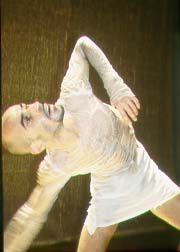
| |
| EMIO GRECO--Getting wet in "Extra Dry." Photo: ©Jean-Pierre Stoop. | |
On a bare stage of blond wood, enclosed on three sides by walls of golden fabric, Emio Greco and his partner, Barbara Meneses Gutiérrez, stood in pristine form-fitting white silk costumes with short skirts.
The ironic title suggests several possible readings. Not that this third section of Greco's dance trilogy—which also includes Bianco and Rosso—is a necessarily tribute to a dry wine or a dry martini.
The fact that initially Greco stands mute and motionless for long moments, while his partner moves forward, undulating expressively, hands searching in the air, suggests almost a laconic quality of observation—as the puppet-master wills his alter-ego to express what he is thinking and feeling.
As the choreography develops, they both are increasingly athletic in their encounters and solo passages. As the dance progresses, they also are increasingly drenched in sweat.
At the close, their white costumes have become transparent with sweat, clinging to their bodies like wrinkled skin on drying corpses.
But they are anything but Extra Dry by this time!
Hieronymus Bosch and Pina Bausch—
Sasha Waltz's Körper Incorporates Earlier Imagery
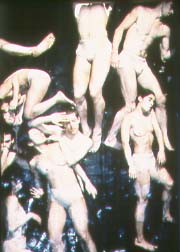
| |
| BODY LANGUAGE--Tangled torsos in Sasha Waltz's "Körper." Photo: ©Bernd Uhlig. | |
Director/choreographer Sasha Waltz is changing all that now. The new thrust is toward a form of dance-theatre, not unlike that initiated by Pina Bausch in Wuppertal.
Körper, or "Bodies," shown in Edinburgh, is a co-production with the Théâtre de la Ville in Paris.
It's of interest—now that the European Union is soon to have a common currency—that theatre, dance, and music co-productions, across national borders, are also becoming a form of common artistic currency.
The danger is not that the act of co-production will become common, but that the artistic quality will.
When the doors opened to Edinburgh's cavernous Playhouse, the piece was already in motion. Two young men moved about in front of a high black wall. On one side, hands, arms, and legs variously protruded from a small hole and made suggestive gestures.
In the center of the wall was a vertically-oriented rectangular aperture with a metal grill. Nearly nude dancers oozed out from the sides and the top of the grill—inside the wall—and proceeded to contort themselves, clinging precariously to the metal rods.
This roiling mass of bodies resembled some scenes from Hieronymus Bosch's visions of Earthly Delights and Hellish Punishments. Certainly not Heavenly Rewards!
The troupe moved easily from Bosch to Bausch, chatting with the audience or talking to anyone who might be listening on stage. This is becoming a bore, for it is seldom witty or incisive.
As a revelation of the dancers' feelings or opinions, it is unnecessary. Audiences customarily come to see virtuosic choreographies and brilliant performers. If they wanted opinions, they could stay home and watch TV talk-shows.
A cute device at the opening was to have a black-clad female dancer move across the stage holding a thin black box with moving red electronic letters. This reminded those of us who had more important things to think about back at the office to turn off our mobile phones. The sign kept re-appearing, with other more dance-related messages.
All dancers wore flesh-colored shorts but were naked above and below. This emphasized the contours, contortions, and definition of their athletic bodies in motion and in repose.
As with Montpellier's Mathilde Monnier and her dancers, so also Waltz and her ensemble: moments of contorted, violent movement, with some lusty thumping of dance partners on the hard floor. Very close to competition wrestling—or crowd-pleasing wrestling fakery.
One of the most interesting movements involved duos of dancers, with one concealed beneath a black cloth—which looked like the skirt of the other dancer. Who showed a naked torso above the skirt.
The cute idea was the apparent reversal of the exposed legs of the covered dancer. In motion and contortion, this effect was even more unsettling, but ultimately amusing.
Suddenly, the high black wall was thrown over toward the audience. Instantly, it became a low inclined plane for the dancers. A long slit from down to upstage was later opened on hinges, so the dancers could lie in line in it.
They also formed an upstage semi-circle of interlocking bodies—which was then able to crawl. These various effects were rather more interesting than Mathilde Monnier's French dance-ideas.
But both shows lacked the customary dominating visual and conceptual vision of a Pina Bausch choreography.
Mathilde Monnier's Les lieux de là—
From the Centre Chorégraphique National
Montpellier Languedoc-Roussillon
One doesn't actually think of Montpellier as a center of avant-garde dance creativity. One doesn't usually think Montpellier of at all, in fact. But, as each French city and region needs its own special vintages, so each city worthy of the name should have some form of cultural activity these days.
Germany has shown the way. No one would ever have heard of Wuppertal, had it not given Pina Bausch a home and a subsidy for her dance-theatre experiments.
There are, in fact, undertones of Bausch's work in Monnier's "Places from there," shown recently in Edinburgh. Her dancers, however, seem much more athletic than Bausch's and also, thankfully, much less talkative.
In basic black on a fairly bare stage, they perform virtuosic or torturous solos, duos, and group gropes and intertwined crawls
On the stage-right side, a wall is lined with corrugated cardboard cartons. Dancers butt their heads or throw their whole bodies against these boxes. On the opposite side of the stage, there is a wall of high wooden sections. Dancers also butt into this, knock their heads against a microphone in the wall, and variously climb up, or descend from, its summit.
When the boxes are fairly totaled, they are removed, revealing a low wall of grey sacks, which are then schlepped across the stage to the other wall.
There are some impressive moments of unison dance. As well as some stressful, violent duos which seem the dance-equivalent of oil-wrestling on the professional circuit.
Heiner Goebbels—who is entirely in tune with Monnier's vision—provided properly stressful and strange music, played solo by Alexandre Meyer.
Foraging on the Fringe—
This August, the Edinburgh Festival Fringe offered no less than 275 World Premieres! Over 23 days—from 6-28 August—there were some 17,000 performances of all kinds of theatre and performance-art. There was a total of 1,350 shows.Extracts from the numerical breakdown: Theatre—479 events, [Stand-up] Comedy & Revue—264 shows, Musicals & Opera—51 productions, Musical Events—340, Dance & Physical Theatre—72, and Children's Shows—64.
Plus talks, walks, art shows, and other oddments—in almost 200 different venues! Not to neglect the many free performances on sidewalks, in parks, and on closed streets. The Edinburgh Fringe is always a form of Performance OverKill.
Nor to overlook the fact that its attractions are competing with the regular Festival and the International Film Festival, the Television Festival, and the International Book Festival! Edinburghers must need the remaining 11 months of the year to recover and prepare for the next onslaught of thousands of tourists and backpackers.
There is a Fringe Festival website, set up for the summer, which may still be operative: www.edfringe.com
At the Church Hill Theatre, the American High School Theatre Festival was in full swing the entire run of the Fringe Festival. There were some plays presented, but—as on Broadway—the thrust was for ever more musicals.
Among the retreaded hits were "Pippin," "Phantom," "Godspell," "City of Lights," Bye Bye, Birdie," "Into the Woods," "Funny Thing," and "The 1940's Radio Hour." Not to worry about Stars of Tomorrow for Broadway musicals of the future!
There was a time when I really tried to sample a little bit of everything on the Fringe—from the National Youth Music Theatre to the Oxford & Cambridge University Revues. I was younger then, but so were Jonathan Miller, Alan Bennett, and Dudley Moore
You won't find many student shows now to compare with their "Beyond the Fringe."
My Fringe Strategy in recent years—which I recommend to first-timers next year—is to begin at the top of the list, with productions at the Traverse Theatre. Then check out anything programmed at the Assembly Rooms, followed by the Pleasance and the Golden Balloon.
There are many other interesting venues—some not easy to reach—with challenging shows. But—if your time is short and your regular Festival program crowded—these are good venues to visit for top-notch productions.
Sitting-In at the Traverse
This August, my time was so short and my program so full that I did not get any further down the list than the Traverse Theatre. Even there, I wasn't able to get a ticket for the sold-out Abandonment," Kate Atkinson's Fringe First winner—which is sure to make its way across the Atlantic soon. This was a Traverse staging, directed by John Tiffany.Nor was I able to see Abi Morgan's equally admired "Splendour." Nor Owen O'Neill's one-man show, It Was Henry Fonda's Fault." Jane and Peter may want to check this one out?
From Island Isolation To Southampton Jar Factory—
Zinnie Harris's "Further than the Furthest Thing"
The very best of the Traverse's own three productions—excluding those shows playing the two Traverse theatres as guests—was "Further than the Furthest Thing." The title refers to an almost forgotten island in the mid-Atlantic. This powerful drama was inspired by the removal of the unwilling inhabitants of the remote island of Tristan da Cunha. These were the descendants of the sailors set down there after the famous Mutiny on the Bounty.
The islanders—completely cut off from modern life—had to leave when a volcano erupted. The play was also influenced by experiences on that barren island by playwright Zinnie Harris's own parents, as missionaries.
Paola Dionisotti was heart-breaking as Mill, the lonely, frustrated wife of the island's leader and lay-pastor. Her strong, silent mate, Bill Lavarello, was strongly played by Kevin McMonagle.
They have had no children and obviously little joy in their lives. Mere survival is the center of their daily round.
So the return—on the once-a-year ship from Capetown—of their nephew Francis [Gary McInnes] is a very big occasion. At least for her. Bill cannot seem to face Francis, or even talk to him.
The play opens, not with the expected arrival of their virtual son, but with the nude Bill splashing in the waters of a mountain-top lake. Suddenly, he seems seized by violent forces and is thrown about in the roiling waters, almost sucked under.
Badly shaken, he returns home to find that Mill has stolen some penguin "h'eggs"—bad luck, surely—to cook as a special treat for Francis. Caressing the eggs, she breaks two of the three—even more bad luck.
Bill is convinced there's some kind of monster—or evil spirits—lurking in the depths of the lake. And that his near-death experience was a warning of evil things to come to the islanders.
He proves right in two ways.
Francis has brought with him a Mr. Hansen [Darrell D'Silva], from South Africa. Hansen proposes to set up a jar-factory on the island, to bottle the islanders' catch of fish.
Bill, as leader of the community, is dead set against the project, to Francis' chagrin. An angry Hansen, his time and money lost on this trip, prepares to leave on the ship.
On his return to the island, Francis finds the girl [Arlene Cockburn] he thought he left behind him already pregnant. But not by him.
Mill wants to get them married anyway, to keep him from going away again. But Francis did not declare himself before he left the first time, so there is no real love left for him.
But Bill was right about the waters, without understanding the warnings of their turbulence.
As Hansen is about to depart, a nascent volcano erupts from the mountain. All the islanders have to be evacuated.
The second half of the drama finds them all in Southampton, working at a Hansen jar-factory. They aren't happy, and they cannot assimilate to English ways and English tastes.
The media have presented these people as freaks, curiosities, and severely inbred.
Hansen has told them all that their homes were engulfed by the volcanic lava. But Mill is determined to raise some money somehow to fly back and see for herself what may have survived.
She is even willing to sell the Dark Secret of the islanders to TV to get the cash.
One year, when Francis was just a baby, the ship didn't come. Near starvation, the islanders divided up the remaining food, against the arrival of the next ship.
But it wasn't enough for all. So seventeen were chosen by lot to go without. As they wasted away before the others' eyes, the sight became unendurable.
So Bill—this was before he found Christ on a trip to Capetown and built the islanders' chapel—rowed these doomed people around the island and abandoned them. Mill's sister, Francis' mother, was one of them.
Hansen—who has developed a special but wary regard for Mill—tries to dissuade her from going back. And especially from creating a scandal.
He reveals the lava stopped before it got to the village. The houses are intact.
He admits he has lied to her. The apparent reason being that the British wanted this isolated island as a special secret base.
Not unlike the current flap about the dispossessed natives of the Indian Ocean island of Diego Garcia. It has been said that the United States wants this lonely island for the same purposes.
As a favor to Francis—who is running the factory—Hansen has put Bill in charge of all the steam-valves in the control-room. Increasingly disturbed in mind and spirit, he breaks and goes wild with the wheels and petcocks.
This is a bleak but powerful play, one that surely should be seen on major stages in the United States and Canada.
Stranded Bulgarian Sailors on Strike
In Sue Glover's Striking "Shetland Saga"
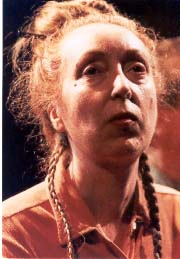
| |
| BULGARIAN STRANDED IN THE SHETLANDS--Anne Lacey in Sue Glover's "Shetland Saga" at Edinburgh's Traverse Theatre. Photo: ©Kevin Low. | |
Memories of her Traverse "Bondagers"—about desperately poor young women, bonded to hard work on Scottish farms—remain vivid. Both because of the spareness of her unsentimental writing and the starkly spare production.
Other impressive Glover dramas include "The Seal Wife" and "The Straw Chair."
Now she has come forward with a new work, which is said to have been inspired by an actual incident. That may be the reason it is less compelling than previous dramas.
Glover's "Shetland Saga," set in Scotland's northern Shetland Islands, involves the efforts of local folk to help stranded Bulgarian crewmen—and a tough Bulgar crew-woman. They are not exactly "on the strand," but rather on a docked fishing ship, the Ludmilla. It is loaded with a very valuable frozen catch.
As with hundreds of thousands in the former Soviet Union and its Warsaw Pact dependent nations, the crew hasn't been paid. And their captain has vanished.
They decided to strike, which is viewed as an act of treason by their government—which sends a secret police agent to intimidate them.
He makes the mistake of trying also to strike terror into the heart of a lonely, orphaned local girl, Mena—who has fallen in love with a moody young seaman on board the ship.
Unfortunately for her, the young man, Svetan, has lied to her. He is married, but separated, and has a child.
Unfortunately for the secret agent, Mena is so frightened and angry at his dark-of-night confrontation with her that she stabs him.
One thing is certain, the Bulgarians will pay dearly, possibly with their lives, if they are forced to return home.
At the Traverse, in festival season, a completely different play must follow—with about a half-hour changeover. So the scenery for "Shetland Saga" had to be implied by set-props, designed by Mark Leese.
One is a big box-like structure, with a gangplank, to suggest the ship. On shore, a rectangular counter serves for all other occasions.
A peculiar feature of this production, staged by Philip Howard, is the accompaniment of the action by a solo violin, played by a young woman who is choreographed around the fringes of the action.
Are You Ready for an International Tour?
Ireland's "Alone It Stands—Munster 12-All Blacks 0"
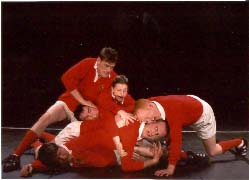
| |
| SOCCER IN LIMERICK--Six actors play sixty characters in "Alone It Stands" at the Traverse in Edinburgh. | |
When I arrived in Limerick late last October, there was not a hotel-room to be had. I was planning to visit the sites mentioned in Frank McCourt's best-selling "Angela's Ashes." Yes, there is a special tour through that sad part of town.
The shortage of accommodation had been caused by the World Cup match the very next day. Banners were everywhere.
But the contenders were the United States and Australia, not Limerick vs. Sri Lanka. Why both teams had to come so far from their respective homes to play in Limerick was beyond me.
But the stands were packed, not only with Ami and Aussie fans, but also with eager locals. In Limerick, they love the game.
But, as "Alone It Stands" comically and athletically demonstrates, the darkest day for Limerick's team was that historic match with New Zealand on home turf back in 1978.
Against all expectations, Limerick's underdog Munster team actually beat the powerful New Zealander All Blacks 12-0! The All Blacks then went on to vanquish all their opponents in the remaining season.
So why was this such a dark day? Because the TV teams had something they thought more important to film in Dublin.
Munster's astonishing victory was never taped for TV! That still rankles.
Director-playwright John Breen has more than made up for that oversight—or Dublin snub—with his wonderful show, "Alone It Stands."
Working with six young, attractive, and very versatile performers, Breen has been able to recreate that memorable day and victory. Five men and one woman play some sixty rapidly changing roles.
But this is not a play-by-play re-run of that game. Instead, Breen has woven high moments from the contest into a fabric of town-life and expectation.
Not least the birth of twins to one team-member. And the excitement of kids, finding or stealing enough burnable materials to make the biggest victory bonfire ever.
All these interwoven moments—including the obligatory Irish singing and dancing—are played on a small gym mat. But Breen and his ensemble make the show even more powerful and focused by confining it to this small space.
That makes it ideal for touring. And this is a show which should delight audiences around the world with its wild Irish humor, warm humanity, and tremendous energy.
This is not only thanks to Breen's talents, but also to his marvelous ensemble: Malcolm Adams, Conor Delaney, David Pearse, Niamh McGrath, Ciaran McMahon, and Andrew Bennet They are splendid.
"Alone It Stands" is a joint production of the Yew Tree Theatre and the Island Theatre. Breen is Artistic Director of the Yew Tree, based in Ballina, County Mayo.
You do not have to love, like, or even know anything about soccer to enjoy this show.
As the New Zealanders perform a Maori dance/chant at the end of the game, I thought—being ignorant of the game and its leading teams—that the All Blacks must be all black. No such thing: they are named for the color of their uniforms!
The things you learn when you go to the theatre!
From Calgary, One Yellow Rabbit
Presents Electrifying "Thunderstruck"
The One Yellow Rabbit ensemble of Canadian Calgary is one of the more interesting avant-garde troupes in North America. Its peculiar brand of text and performance has won both awards and world-wide attention. On my last trip to the Pan-Canadian Drama Festival in Calgary, I was astonished by One Yellow Rabbit's evocation of the life and work of poet Leonard Cohen: "Doing Leonard Cohen." This later toured widely.
One Yellow Rabbit is also no stranger to the Traverse and the Fringe, having previously won Fringe Firsts. This season, its touring show is Daniel Danis' high-tension French Canadian drama, "Thunderstruck." Danis had already won praise for "Stones and Ashes," shown on the Fringe.
Translated into English by Linda Gaboriau, the weird play's subtitle is: "The Song of the Say-Sayer/Le Chant du dire-dire." Two of Yellow Rabbit's guiding lights are credited with mounting the production: Blake Booker for direction, and Denise Clark for staging.
The Say-Sayer is a small constructivist frame of a house—devised to encourage an autistic child to talk into the model-house what cannot be said to the family.
It very much resembles the house-frame in which three brothers and their seriously chubby sister live, following the dreadful death of both parents when lightning struck their home.
The kids were obviously already peculiar, but thunder-bolts didn't improve their world-view—or their relations with the ordinary folk of the community.
Struck directly, their sister remains comatose, not dead. But she mysteriously glows, drawing the curious and some who hope to be healed.
Clearly, this is not "Our Town" or "Life with Father."
Elizabeth Stepkowski plays the sister, who entertains the entering audience in her Country & Western cowgirl outfit as she sings a show-related ditty.
Her three protective brothers are Michael Green, Andy Curtis, and Denise Clark.
From Netherlands' Theatergroep Hollandia—
Jeroen Willems' Award-Winning "Voices"
"Voices" has won—and its solo performer with it—a variety of prestigious theatre awards. Jeroen Willems is certainly demonstrating virtuosity in moving from place to place at a seriously messy dinner-table to impersonate five quite different but powerful characters. One of them is identified as Cor Herkströter, chairman of Shell International. What he has to say about doing global business in Third World countries is clearly meant to seriously disturb Human Rights & environmentally protective audiences.
Unfortunately, his cynically pragmatic remarks are right on target. The other voices animate texts by the late Italian film-maker Pier Paolo Pasolini. They reveal the seamy hidden side of modern society in a free market world.
One of the voices is an outrageous woman, for whom Willems dons a wig, vamps outrageously, and tells a Faustian tale of a man who bargains with the Devil to win sainthood. Pure Paolo Pasolini!
A critical comment from Rotterdam's Dagblad says it all: "…Willems portrays the row of despots in such a way that even the average environmentally-conscious, ethically-responsible, justice-loving Western citizen of the world with all his fine ideas is turned to pulp, and that is what makes the solo brilliant."
While Traverse audiences clearly enjoyed the performance, no one was reduced to pulp.
From Ulcerous Ulster—
Ridiculusmus Duo in "Say Nothing"
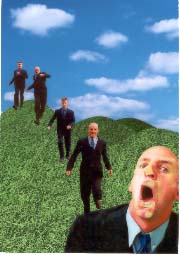
| |
| IN NORTHERN IRELAND, 'SAY NOTHING"--Irish duo of David Woods & Jon Hough give their neighbors the Ridiculusmus Treatment. | |
One way of ignoring—or rising above—the continuing Protestant-Catholic, Unionist-IRA confrontations in Northern Ireland, as their new show's title suggests, is to "Say Nothing."
Woods plays Kevin, an English Ulsterman, just back from England with a doctorate in Peace and Conflict Studies. Confronted by an avid Orangeman, a peculiar B&B landlady who won't let him have his bed, and others—all played by Hough—he loses his cool. He proves to be the last person you'd call in to resolve a conflict.
The team thrives on repetition of lines. But this may also suggest that, having nothing really to say, people often fall back on repeating clichés.
Especially if the realities of life around them are too appalling to be discussed. And to be dealt with—and resolved.
My problem with the show was not the unfunny repetitions of trying to position the English town of Goole—with gestures in the air—amongst literary territories such as James Herriot and Brontë Land. The real difficulty was rather with the Ulster accents of Hough, who spoke very rapidly and in a generally low voice.
Super-titles would have helped immensely. [Loney]
Copyright © Glenn Loney 2000. No re-publication or broadcast use without proper credit of authorship. Suggested credit line: "Glenn Loney, New York Theatre Wire." Reproduction rights please contact: jslaff@nytheatre-wire.com.
| home |
reviews |
cue-to-cue |
welcome |
| museums |
recordings |
coupons |
publications |
classified |